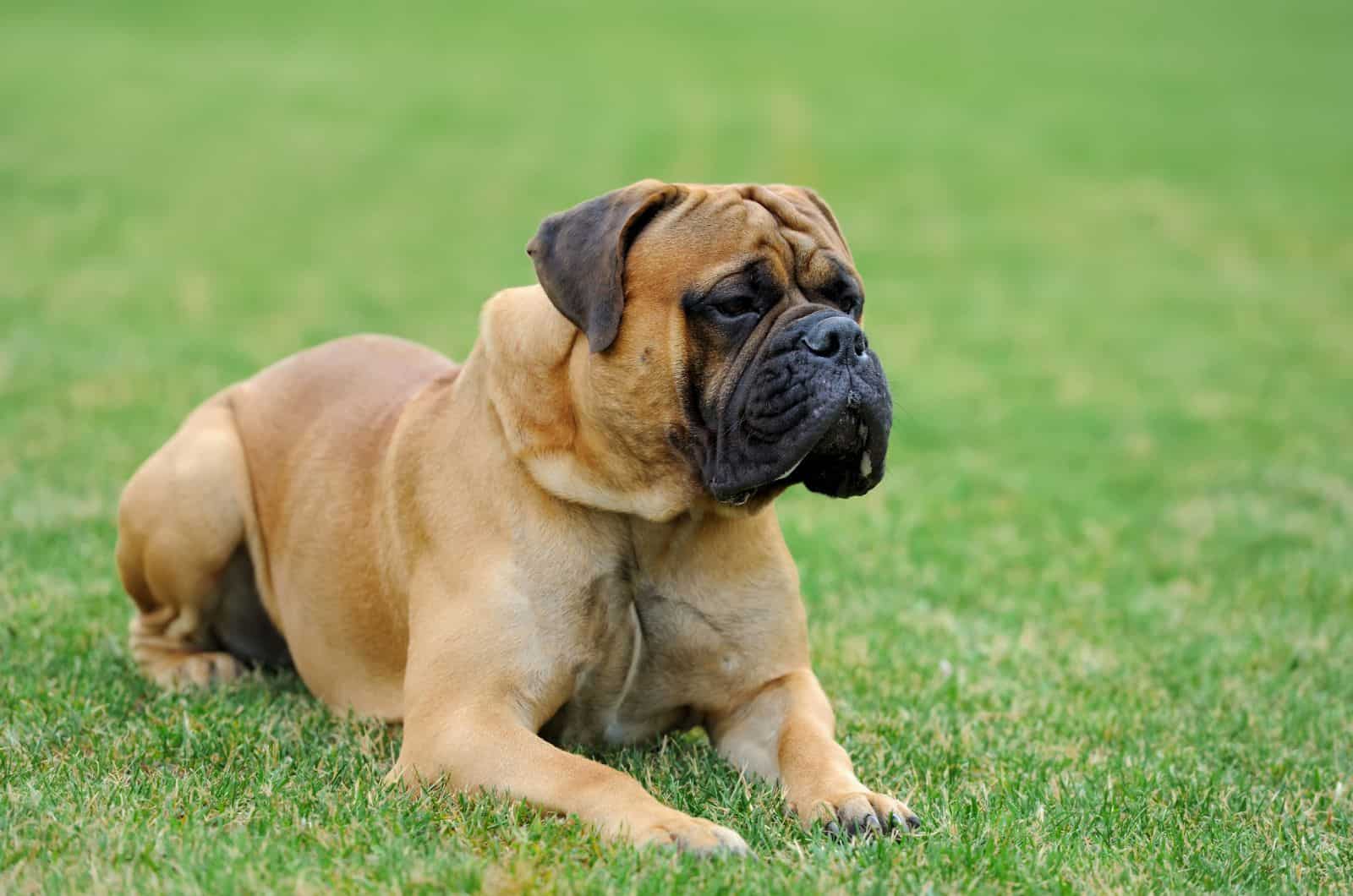The English Mastiff growth chart should be the best friend of every owner of this breed from the first day they receive this amazing pup.
Also known as the Old English Mastiff, this magnificent dog breed has been known for centuries as a great working and guard dog.
No matter whether they come in brindle, fawn, or apricot coat shades, English Mastiffs are excellent family canines that will dedicate their life to protecting their owner and property.
However, if you plan to own this large doggie, there are some things that you should pay attention to such as its weight, height, and overall development.
That is why we decided to present you with one of the most beneficial charts that will help you track your pup’s progress as it grows.
English Mastiff Growth Chart
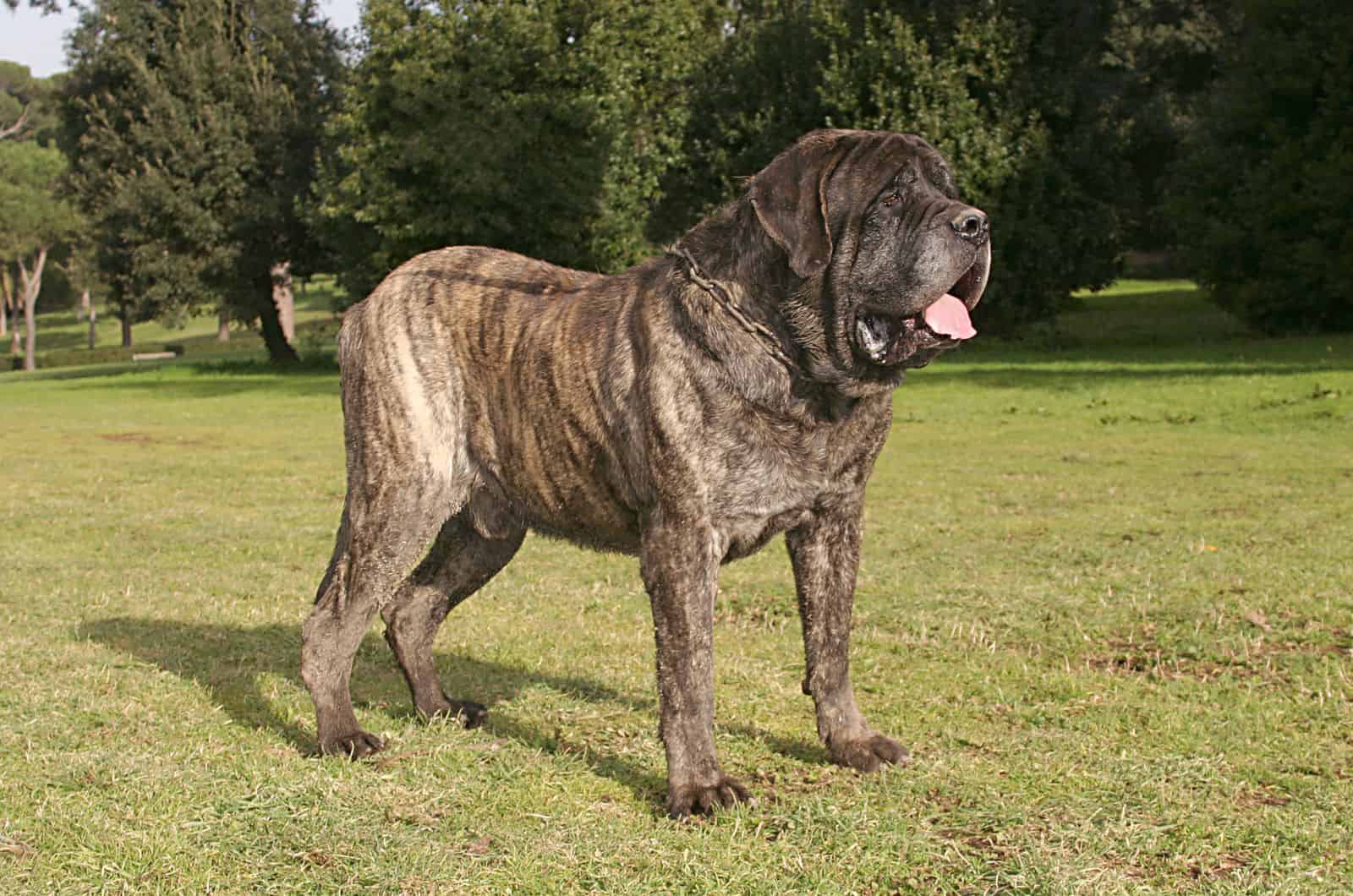
Tracking your pet’s growth rate is highly beneficial for its health. Every exception in their weight or height from the chart guidelines can be considered as a sign of certain health issues.
Of course, medical conditions aren’t the only reason why your pup might not fit in the monthly development chart of their breed as certain pups have their own pace at which they grow.
However, if you notice that your pup’s growth is significantly different from the measurements stated in the tables below, it would be best to contact a veterinarian and take your pet for a checkup.
[table id=626 /]
English Mastiff Weight Chart
[table id=628 /]
English Mastiff Puppy Growth Chart Through Weeks And Months
First Two Weeks
Breeders and owners don’t have much to do immediately after the birth of English Mastiff puppies as they’re still strongly attached to their parent (mother) during this period.
English Mastiff pups, like any other dog breed, don’t have developed hearing and vision, so they fully depend on their mother for everything.
She is the only one who can take adequate care of the puppies. Keep in mind that the mother is very protective of her offspring, so she might show hostile behavior if anyone tries to go near them.
At this point, the only thing the puppy does besides sleep is wriggle around its fellow sucking littermates in an attempt to find a feeding spot.
When it comes to feeding, make sure that the mama Mastiff has enough food as she will need to eat at least two or three times more than usual.
However, the best way to know how much food she’ll need is by consulting your vet. This way, you will avoid any chance of your adult Mastiff becoming overweight, which is quite common during the nursing period.
First Two Months
As they grow older, English Mastiff puppies will become more social and start taking notice of their littermates, as well as of human family members. This period is very important as they make their first social interactions with other beings than their mother.
They will start learning about the world around them, and you’ll notice when they start exploring their environment. However, they won’t be able to explore the whole house just yet as they’re still not very stable on their feet.
The weaning process begins when the puppies are between two and four weeks old. During this time, they begin to drink less milk from their mother. You will know when the weaning process begins as the mother won’t be present around her puppies as much as she was.
At this time, the puppies will be able to start consuming wet dog food or kibble that has been softened with puppy formula.
They should be completely weaned by the time they are two months old.
Potty training can start from the fifth week of the puppies’ life if they are able to follow their mother outdoors.
Initial Socialization Period
The importance of socialization cannot be overstated. It is important to encourage the puppies to engage in social interactions during this period as it will benefit them in the future.
Puppies may be weaned from their mother at around eight weeks of age, but even before that, they can start learning certain fundamentals, such as how to behave appropriately, and avoid being too vocal or prone to biting.
Three To Six Months
English Mastiff puppies should have been placed in their forever home between the eighth and tenth week of their life. The pups are developing at such a rapid rate that it can occasionally feel as if they’re growing in minutes, not weeks.
Their high energy levels start to show in this period as they become excited and joyful about almost everything that happens around them.
Early training in the preceding growth stage will involve getting the pup acquainted with a collar and leash, but you shouldn’t take small English Mastiff puppies out for extremely lengthy walks or involve them in exercises that are particularly rigorous just yet.
Puppies are developing both physically and mentally during this time, so it’s essential to train them in proper behavior. Basic commands, obedience, and socialization training should be intensified as soon as they turn three months of age.
It’s easy for them to develop negative habits if they’re not properly trained, which can cause behavioral issues in the future.
If you are not particularly experienced in the process of bringing up a puppy and teaching it manners, you can contact a professional dog trainer who works with giant breeds.
Big pups might be challenging to work with as most of them inherit stubbornness as a personality trait from their ancestors.
Seven To Nine Months
At this point in life, an English Mastiff puppy should already have established habits and routines throughout the day.
Meal time, stroll times, and basic obedience practice should become a matter of routine – despite the fact that your adolescent puppy may undoubtedly test your patience occasionally by attempting to test the limits of its authority.
That is why it’s important for the dog owner to establish dominance and show who’s in charge, not only inside, but also outside of the house.
Both female and male English Mastiff dogs can be kept as in-house pets, but only if they’ll spend quality outdoor time with their dog owner on a daily basis.
If they’re kept indoors for a long time, these pups might develop destructive behavior, not only because of separation anxiety, but also boredom as they possess high activity levels.
Considering that they’re giant dogs, you can’t even imagine what kind of mess these canines might make if they go into destructive mode.
Ten To Twelve Months
The growth rate usually slows down at this point, but it’s far from complete as these pups will continue developing in the next few years as well.
Although they will already appear large during this period, keep in mind that your Mastiff is still a puppy, so don’t be surprised by their mischievous behavior and excitement about every activity they’re involved in.
Dog walks (ideally twice a day) will be of the same benefit to you as they are to your canine companion since they will burn off at least part of the excess energy.
However, walking alone can’t prevent excessive weight gain. If you want to avoid obesity, you should take care of the dog’s diet as well, and not only its physical activity.
To determine how much physical activity is enough for your dog on a daily basis, a good rule of thumb is to allocate five minutes of walk time per month for its age.
Adults
The pup and the owner are supposed to have a healthy relationship established by the time it turns into an adult canine.
This way, the large dog will be able to function with all family members without any problems, and will rarely display any negative behavior towards them.
English Mastiffs have a calm disposition, and they are quite loyal and cuddly; nevertheless, due to their size, even behavior that is considered to be relatively gentle might be a little bit overpowering.
These dogs will be great with children, but they’re not recommended as pets for families with babies and toddlers. If you’re expecting a new member of your family, and you have dogs like Great Danes, English Mastiffs, Saint Bernards, and other Mastiff types of canines, you shouldn’t leave the baby with them without supervision.
RELATED: Male Vs. Female Great Dane: Which Gentle Giant Is Your Choice?
The main reason for this isn’t their aggressive behavior as most of them aren’t aggressive by nature, but their size. Big dogs are often not aware of their size, so they might become too playful and harm a child accidentally.
On the other hand, a pup that has been well socialized and has received a lot of attention will develop into a lovely furry friend that enjoys spending time with you above all else.
How Big Do English Mastiffs Grow?
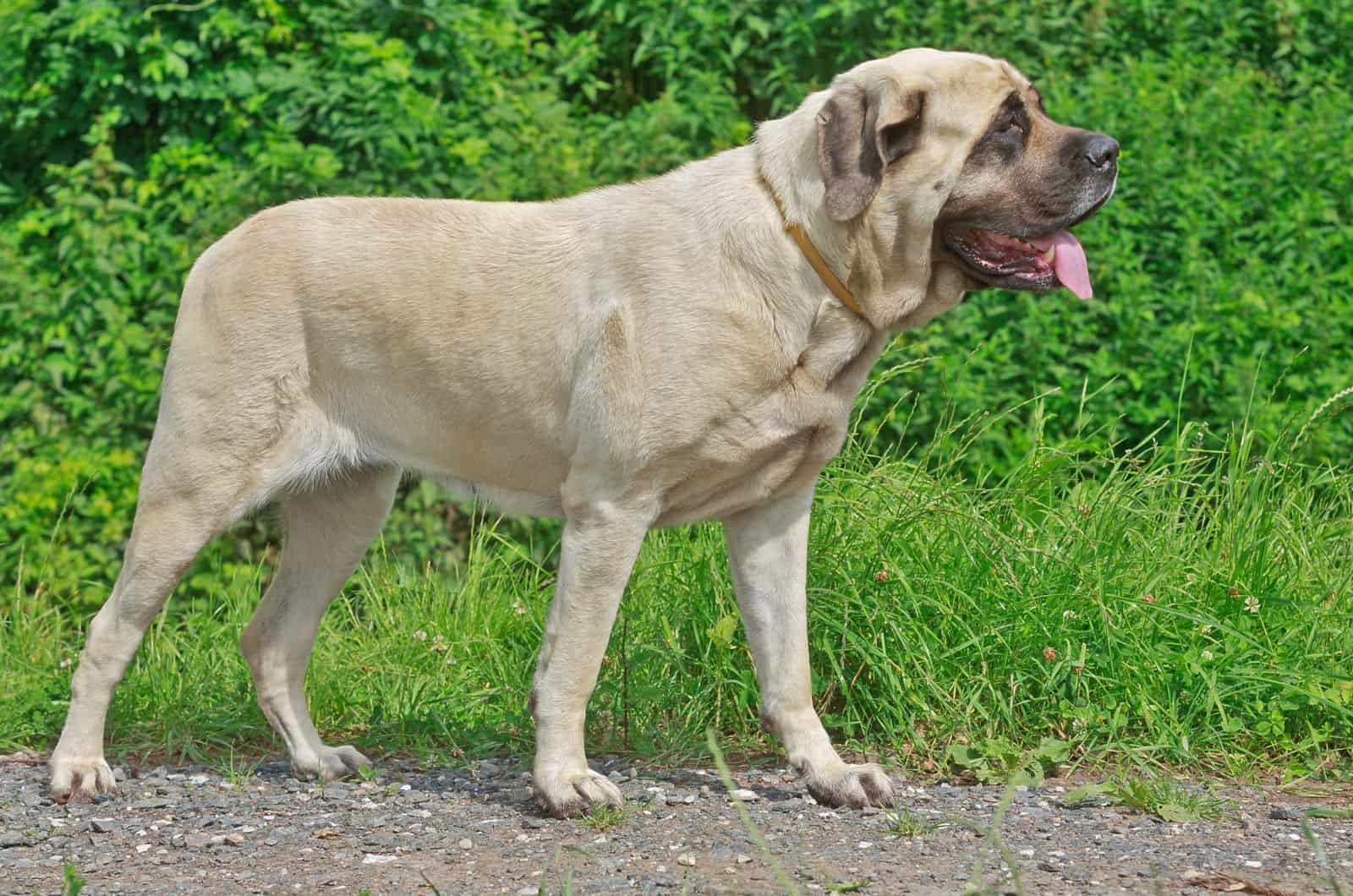
If you want to get an idea of how big your English Mastiff will grow to be, observing the size of his parents is one of the most effective methods to do it.
If you look at the pup’s ancestors, you can get a notion of the size that it will grow to be.
In general, English Mastiffs reach a full-grown size that falls somewhere in the middle of that of their parents.
Another way to determine the dog’s size is to examine its paws. Although this approach is not infallible and not the most exact solution, it may go a long way toward telling you about the development of your pet.
If you see that your English Mastiff’s paw is much bigger in contrast to the rest of his frame, then you may deduce that it still has some maturation left to complete.
DNA testing is another alternative that can be utilized to precisely trace the genealogy of your dog in order to make accurate projections regarding its future growth.
If you have exhausted all other options, then you may fall back on reviewing the English Mastiff growth chart, which is a general calculation of a Mastiff’s growth according to the breed standard.
Therefore, male English Mastiffs usually grow up to 30 inches or more, while female pups grow between 27 and 28 inches (although they can be even taller than that).
How Much Should English Mastiffs Weigh As Adults?
These pups are known as giant dogs for a reason as their average weight ranges from 200 to 230 pounds when they reach full size, according to the breed standard set by the American Kennel Club (AKC).
English Mastiffs are one of the largest dogs as they’re larger than the majority of big canine breeds, including Bullmastiffs, Great Pyrenees, Great Danes, Bernese Mountain Dogs, and others.
They’re naturally large canines, which is why Mastiff owners should take special care of their diet. These pups can easily become obese if they’re not properly fed.
If you’re not sure about the amount of dog food English Mastiff-breed dogs should have during every meal, you can consult with a puppy expert or a veterinarian.
It’s better to ask for additional opinions and make sure that they’re fed properly rather than battle health issues that might be a result of obesity.
How Long Does It Take For A Mastiff To Grow To Full Size?
The majority of English Mastiffs don’t reach their full growth after they turn one year of age as they require at least one and a half to two years to fully develop.
Small and medium dogs like Bulldogs, Basset Hounds, Chihuahuas, English Cocker Spaniels, Aussies, and other breeds usually reach their adult size at twelve months of age, but that’s not the case with large canines such as English Mastiffs.
Some of these dogs might grow up to three years as well, so there’s no need to fear if you notice that your pet hasn’t reached its full size until it’s two.
This is one of the most interesting features of English Mastiffs, especially since they go through growth spurts during puppyhood but still mature at a slower rate than other canine types.
Factors That Can Affect the Size of English Mastiffs
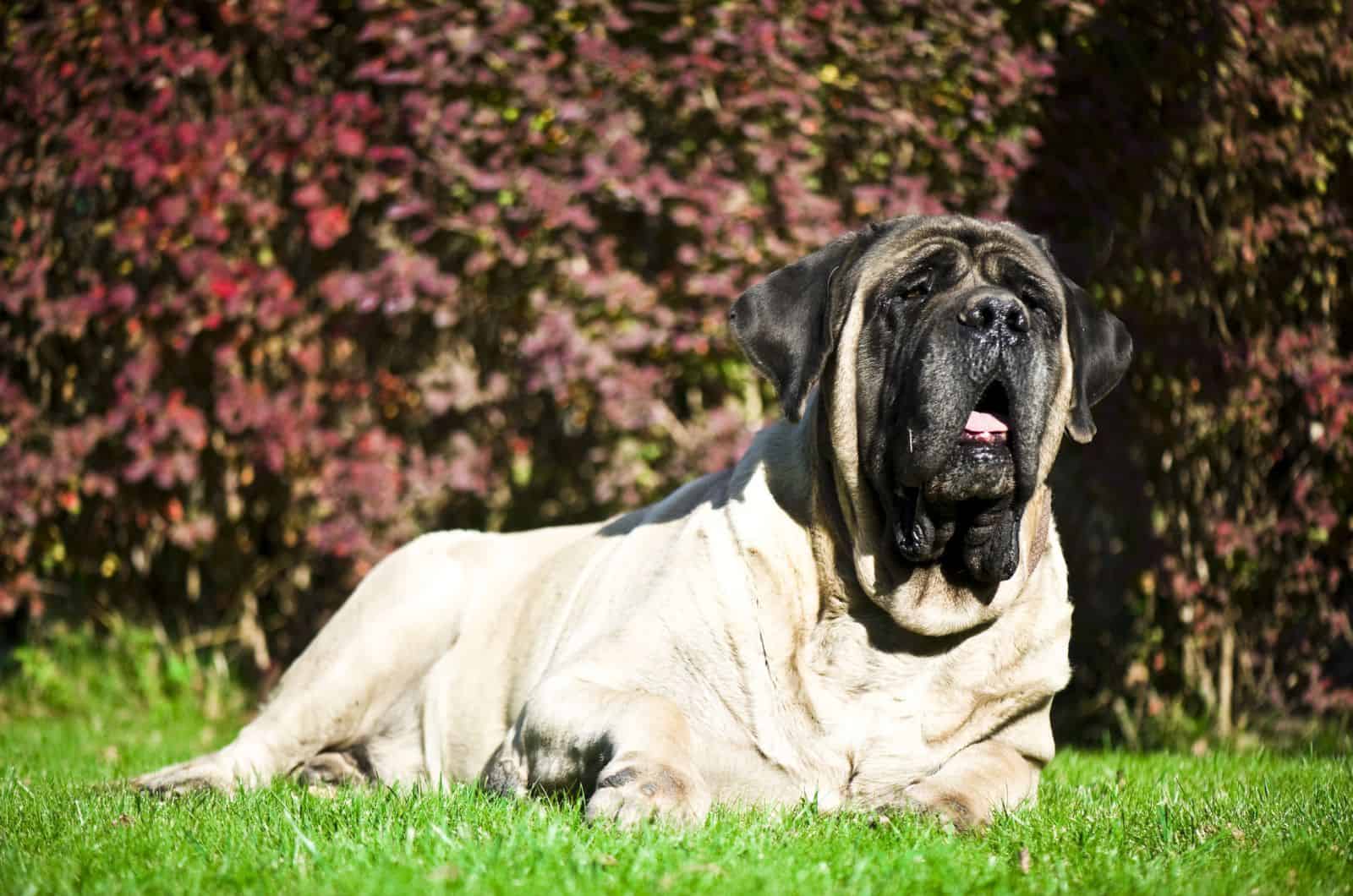
The Mastiff is a breed of canine that is known for its imposing size. There is no mystery as to why the majority of people refer to these canines as giants.
On the other hand, despite the fact that Mastiffs are considered to have a certain height and weight range, which makes them large-breed dogs, not every pup is the same.
Therefore, your Mastiff pet might not reach the size stated in the growth chart, which is perfectly fine.
However, if you’re worried about the growth of your pup regarding its weight or height, you can take your pup for a regular checkup to make sure that everything’s fine.
When certain variables are present, it is possible for Mastiffs, just like people, to either put on too much or too little weight. The most common causes of variations in a Mastiff dog’s size are:
• Overeating – One of the most prominent elements that affect the size of a Mastiff is the amount of food it receives during its meals.
If a Mastiff doesn’t eat for a long period of time, it will develop malnutrition and lose weight. However, if it eats on a regular basis, it will keep a healthy weight.
Your dog will gain weight if it eats an excessive amount of food and does not get enough exercise on a regular basis. Because of this, it is possible for your male Mastiff to reach weights in excess of 200 or more pounds (everything over 230 pounds is considered too much).
In a similar manner, when Mastiffs eat an insufficient quantity of food, they run the danger of becoming underweight.
• Improper diet – In addition to eating enough, you need to make sure that your Mastiff eats appropriate food.
Just like any other breed of canine, Mastiffs have certain dietary requirements that must be met in order for them to develop normally and remain healthy as they age.
It is essential for Mastiffs to consume appropriate proportions of healthy fats, carbs, and proteins, among other macronutrients, in order to obtain the necessary amount of energy; yet, doing so will also prevent them from putting on an unhealthy amount of weight.
They require different types of diets at various points in their life, depending on the developmental stage they are in.
The quality of food plays a major role in the development of canines, especially during puppyhood. Therefore, make sure that your pup is fed high-quality food as it will benefit its health and growth in the long term.
• Physical activity – This is an equally important aspect that can highly affect the size of your pet.
Training and daily exercises should be an essential part of a Mastiff’s daily schedule to keep it fit and entertained. Mastiff canines (almost every type of this breed) are fiercely energetic.
However, if they don’t have enough space and time to get rid of the excess energy, it can impact their mental health and their physical appearance.
Keep in mind that they eat larger amounts of food, so they might become overweight if they’re not properly exercised.
Can Neutering/Spaying Affect An English Mastiff’s Growth?
When it comes to spaying and neutering big dogs like English Mastiffs, it shouldn’t be done before they turn twelve months of age.
Actually, it would be best to wait until the pup is at least sixteen months old before you spay/neuter it as it can have an impact on its physical development and on its health in general.
Allowing the dog to grow and achieve full size before spaying/neutering can lower the chance of bone and joint issues like elbow or hip dysplasia, which are common among big canine breeds.
The English Mastiff’s body frame might not develop properly if the procedure is done before it is fully grown.
Skeletal problems aren’t the only way sterilization can affect the growth and health of your pet.
Particular tumors, musculoskeletal illnesses, behavioral issues, endocrine abnormalities, obesity, and urinary incontinence may be associated with premature spaying/neutering.
How Do You Properly Measure Your English Mastiff?
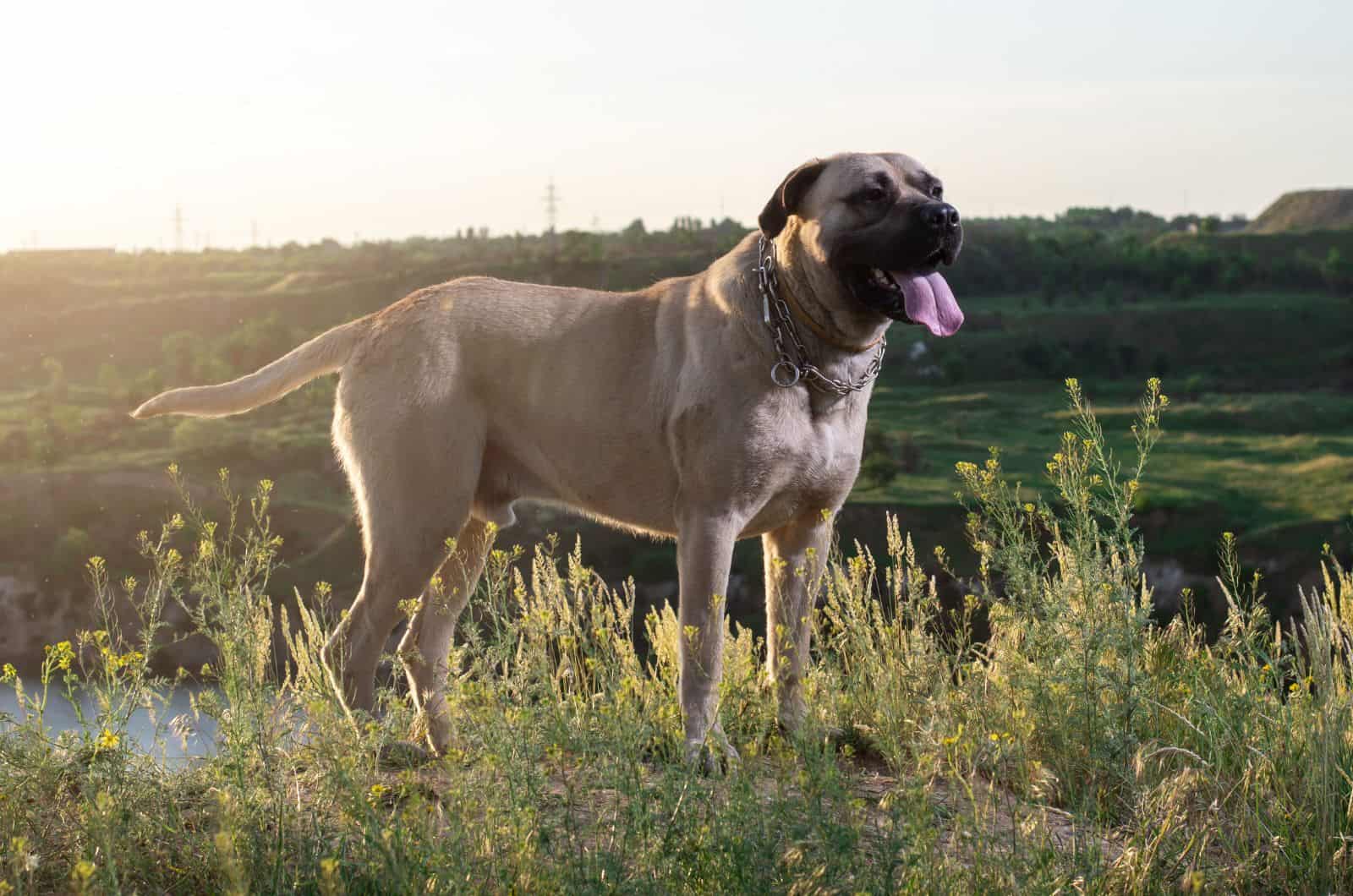
Measuring your pup during different stages of its life is crucial as it’s one of the best indicators of the canine’s well-being.
Abnormal changes in a dog’s growth can be symptoms of certain health issues, which is why you should take your pup to the vet if you notice that it is not developing at the same rate that is stated in the growth chart.
Measuring an English Mastiff puppy is a piece of cake as you’re still able to pick it up and hold it in your hands long enough to measure it.
However, as it grows older, its weight becomes greater, which will make it physically impossible for the owner to measure an English Mastiff by holding it in their arms.
The best way to weigh an adult Mastiff is by taking it to the vet if you don’t own a large scale. This way, you will get the precise measurement of your pup.
Body Condition Score (BCS) For English Mastiffs
The Body Condition Score has become one of the standard methods for evaluating the weight of canines. Many people refer to it as the BMI for dogs, which isn’t far from the truth, although the BCS isn’t measured quite the same way.
The body condition score is a number issued to your dog based on an assessment of fat in several key areas of its body.
A BCS can have a value ranging from one to nine. A BCS of one indicates that a canine is dangerously underweight, and is likely to pass away from malnutrition.
If the dog is rated at nine, this indicates that the animal is highly obese, coated in fat, and in danger of developing numerous obesity-related diseases.
BCS calculations may normalize dog proportions and be used to provide food and activity recommendations for your pet.
How Do You Measure Your English Mastiff According To Its BCS?
There are certain guidelines that should be followed if you want to find your pet’s BCS score. The proper way to measure your pooch is:
• By keeping your dog standing straight, so you can see the dog from the sides and from above, and check the visibility of the fat and bones on its body.
• Check the rib cage by going over it with your hand. If there’s no fat between the skin and the ribs, the canine is considered underweight. If there is a layer of fat under the skin, but the ribs can be felt, your pup is of perfect weight.
On the other hand, if you barely feel the ribs (or don’t feel them at all), then the canine is considered overweight.
How Do You Measure An English Mastiff’s Height?
Measuring your Mastiff’s height is a simple process that doesn’t require any special equipment.
The measurement should begin at the withers as this is the tallest point of the canine.
Try to put your pup against a flat surface, be it a wall or door. Locate the dog’s withers, which are essentially the pointy places on the canine’s neck.
Once you’ve found the withers, you can mark that point on the wall behind the pooch. Once you have the mark on the wall (or other surface), you can measure the height from this point to the ground.
This is the simplest way to determine height, not only for English Mastiffs, but for other canine breeds as well.
How Long Do English Mastiffs Live?
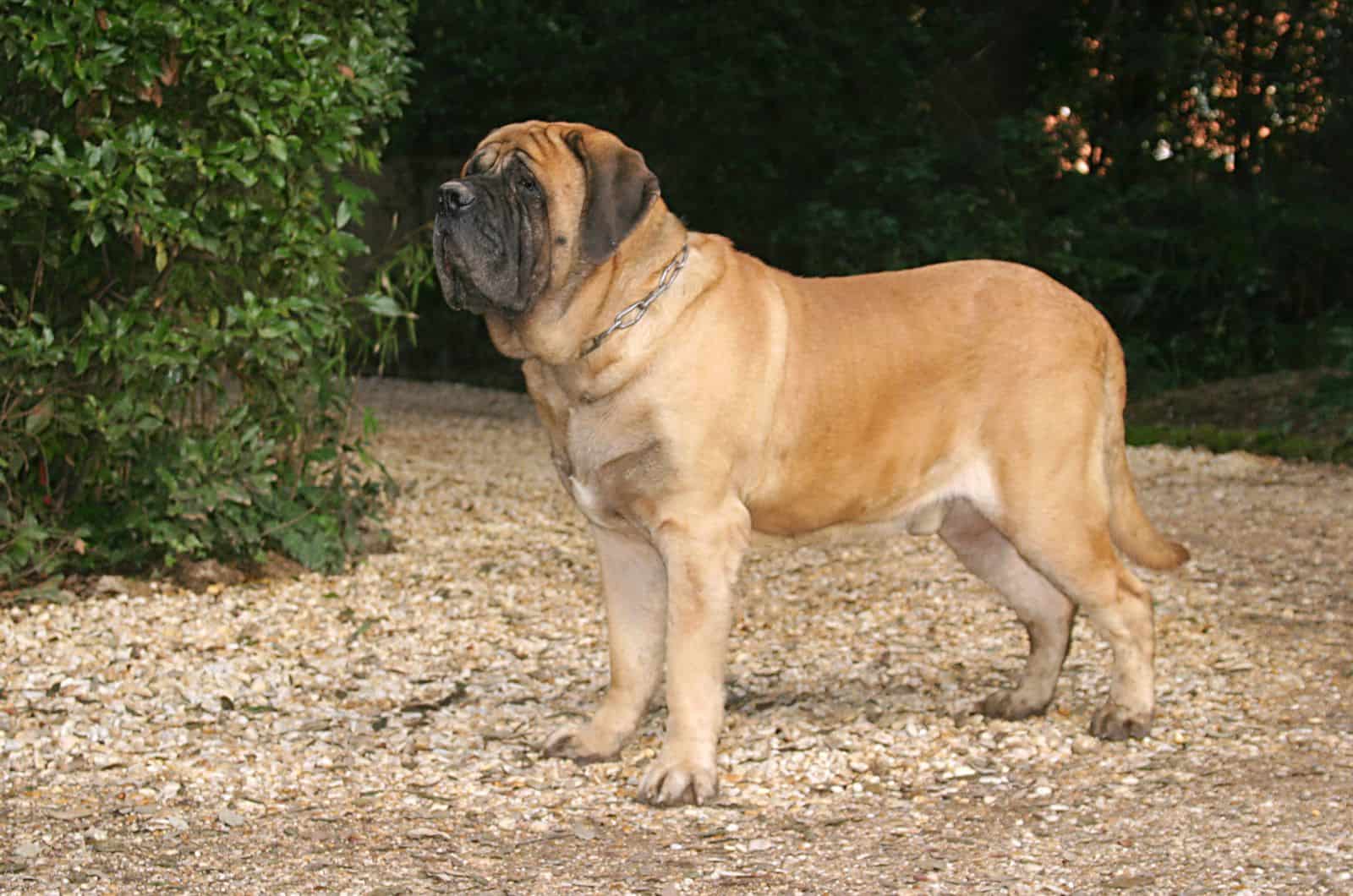
Unfortunately, the majority of large canine breeds have a short lifespan, including English Mastiffs, Great Danes, Afghan Hounds, Beaucerons, Anatolian Shepherd Dogs, Bernese Mountain Dogs, etc.
RELATED: 30 Alaskan Malamute Mixes: When The Fluff Prevails
The typical lifespan of an English Mastiff is between six and ten years; however, dogs with appropriate treatment, healthy genes, and a bit of fortune have been documented to live up to fifteen years.
Providing high-quality nutrition, engaging in regular physical activity, and keeping up with vaccines are all important factors in ensuring a long and happy relationship with your pet dog.
However, if your pup doesn’t make it past ten years of age, there is no reason to blame yourself, especially if you provided it with utmost care.
What Is The Price Of An English Mastiff Puppy?
English Mastiffs aren’t an expensive breed considering that the price of canines like Tibetan Mastiffs, Rottweilers, German Shepherds, Chow Chows, Samoyeds, and other pups is much higher.
Of course, the price of the puppy depends on the breeder and their location, as well as on the quality of the canine, but the majority of these pups cost between $1000 and $1200. Champion bloodlines will always be more expensive than “regular” pups.
Of course, the initial price isn’t the only cost regarding these large guard dogs. These pups love to eat, but they also need high-quality food, which costs more than dog food of lower quality.
Considering that Mastiffs can be pretty strong-willed pups, you might need the services of a professional dog trainer. However, this is a great long-term investment as it will pay off by having a well-behaved canine with good social skills.
Toys, dog beds, brushes, collars, and harnesses are essentially additional costs that will add up throughout the years of owning your Mastiff.
However, if you’re looking for lower-priced, good-quality dog equipment, including the things I mentioned above, you can check websites like Amazon, Chewy, or other online shopping sites that contain these products.
Wrapping Up
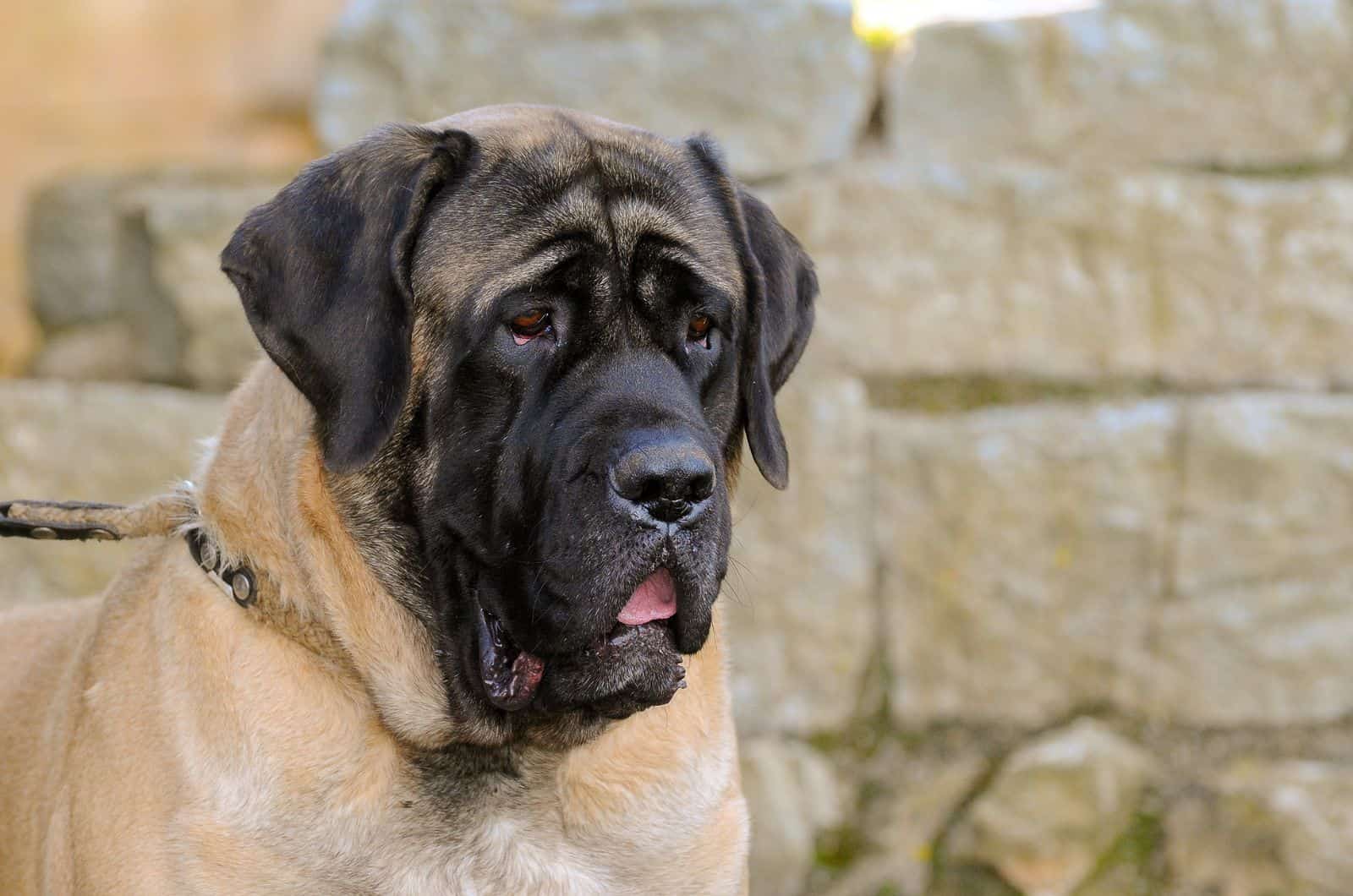
A lot of Mastiff owners will agree that the English Mastiff growth chart is a highly beneficial tool during the first years of the pup’s life.
Owning both purebred or mixed English Mastiff puppies is a great responsibility as these giant dogs require a lot of care and a dedicated owner, but it comes with a great number of benefits as well.
These canines are great guard dogs, and they’re completely obedient to their owner, especially if they’re properly trained.
However, as their owner, you will need to check their weight and growth in general regularly as they have a tendency to become overweight.
The best way to do this is to measure your pup frequently, and follow the guidelines in our English Mastiff growth chart.
READ NEXT:
North American Mastiff – A Gentle Giant Overview
